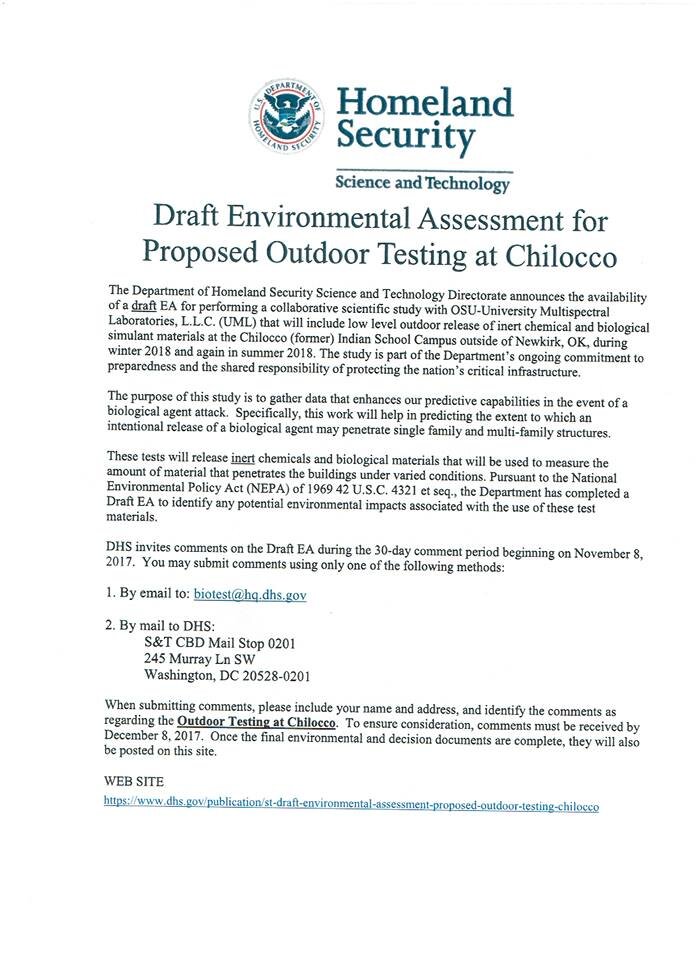nivek
As Above So Below
The Department of Homeland Security is planning to test chemical and biological agents at the former Chilocco Indian School campus in Oklahoma in early 2018, and they are being met with protests from people concerned that they aren’t being given the whole truth about the tests.
According to a letter from Homeland Security, the Science and Technology Directorate announced the availability of a draft EA for performing a collaborative scientific study with OSU-University Multispectral Laboratories, L. L. C. (UML) the would include “low level outdoor release of inert chemical and biological simulant materials at the Chilocco (former) Indian School campus outside of Newkirk, OK…”

That letter states that the purpose of the testing is to “gather data that enhances our predictive capabilities in the event of a biological agent attack. ”
“Specifically, this work will help in predicting the extent to which an intentional release of a biological agent may penetrate single family and multi-family structures,” the letter adds.
DHS assures us that the materials they are going to release are “safe,” and what are those materials? According to their website:
A question is then posted on the DHS website, “If these materials being used in testing are safe, why are the workers wearing goggles, gloves, masks, and other personal protective equipment (PPE) during testing?”
Read more:
Homeland Security Plans Chemical & Biological Testing At Chilocco In Oklahoma
According to a letter from Homeland Security, the Science and Technology Directorate announced the availability of a draft EA for performing a collaborative scientific study with OSU-University Multispectral Laboratories, L. L. C. (UML) the would include “low level outdoor release of inert chemical and biological simulant materials at the Chilocco (former) Indian School campus outside of Newkirk, OK…”

That letter states that the purpose of the testing is to “gather data that enhances our predictive capabilities in the event of a biological agent attack. ”
“Specifically, this work will help in predicting the extent to which an intentional release of a biological agent may penetrate single family and multi-family structures,” the letter adds.
DHS assures us that the materials they are going to release are “safe,” and what are those materials? According to their website:
- Inert Particle 1 is titanium dioxide (TiO2), a white odorless, non-hazardous, non-flammable, and non-reactive powder that does not dissolve in water. Titanium dioxide is commonly used in paints, food, cosmetics, and insecticides. As an example, sunscreens containing titanium dioxide are recommended by medical experts to effectively block certain harmful UV rays.1 Titanium dioxide is not regulated or defined as a toxic or hazardous material.
- Inert Particle 2 is a 90:10% mixture of urea powder with CL Fluorescent Brightener 220. Urea is the main chemical found in human and mammalian urine and is used worldwide as a fertilizer. CL Fluorescent Brightener 220 is a non-hazardous optical brighter found in toothpastes and laundry detergents to make whites appear brighter.
- The Biological Particulate will be a preparation of Bacillus thuringiensis subsp kurstaki (Btk) spores that have been “barcoded.” Bacillus thuringiensis kurstaki is a microbe found on plants and in soils everywhere, is nonhazardous to humans, and used widely by farmers nationally to kill specific crop destroying insects, particularly those employing organic gardening practices. These spores can be purchased for home-use at stores selling gardening supplies, and are considered safer than traditional chemical pesticides. The “barcode” in these materials will allow DHS and our performer to conclusively identify the material we use from any that might occur naturally or be used by a farmer on nearby fields. This material simulates the kind of material that might be used in a bioterrorist attack on U.S. citizens.
A question is then posted on the DHS website, “If these materials being used in testing are safe, why are the workers wearing goggles, gloves, masks, and other personal protective equipment (PPE) during testing?”
Read more:
Homeland Security Plans Chemical & Biological Testing At Chilocco In Oklahoma
